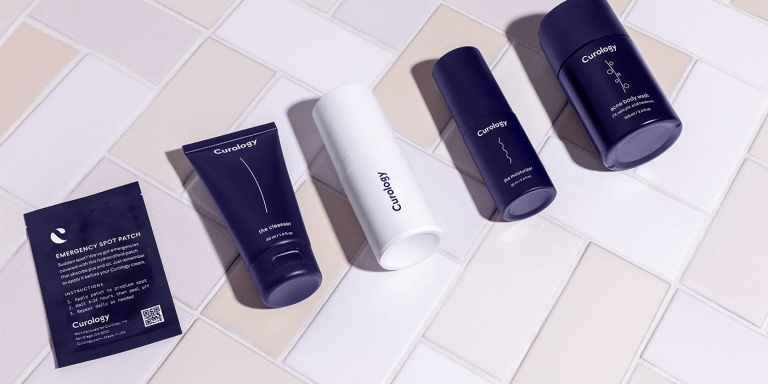How it works:
Share your skin goals and snap selfies
Your dermatology provider prescribes your formula
Apply nightly for happy, healthy skin
How it works:
How it works:
Share your skin goals and snap selfies
Your dermatology provider prescribes your formula
Apply nightly for happy, healthy skin
How it works:
The best cleansers for combination skin, explained
If your skin’s oily and dry, these cleansers may be an ideal choice for you.



Wine and cheese, peanut butter and jelly, cookies, and cream—a good combination is great, but it’s less fun when it describes your skin type!
Combination skin is typically characterized by dry and oily patches that can make caring for your face seem a bit confusing. If your skin falls into this category, you’re in luck—our experts are here to give you the inside scoop on what combination skin is and why treating it with balancing ingredients can help. We’ll also give you a checklist for choosing the right cleanser for combination skin and discuss how different skincare ingredients may work for you.
What is combination skin?
Did you know that combination skin may be the most common skin type?¹ It usually presents with an oily T-zone and dryness throughout the rest of the face. The hairline, jawline, or cheeks may feel dry and tight, while the nose and forehead may be slick and shiny. In oily areas, the pores may appear more prominent, and dry skin patches and acne breakouts are common.
How to know if you have combination skin
No two people have the same skin, but people with combination skin often experience dry patches on their face alongside an oily forehead and nose. People with this skin type may also experience symptoms of sensitive skin.
Still not sure if your skin falls into this category? To help you figure it out, we came up with a few steps to follow:
Use a gentle cleanser to wash your face.
Wait for approximately one hour.
Examine your skin. If some areas of your face have become oily again, you probably have combination skin! It’s as simple as that.
Building a skincare routine for combination skin
If you have combination skin, different areas of your face likely have different needs. Enter: Cleansers that are formulated to balance hydration and oiliness. Using the right face wash for combination skin can help dry areas feel more hydrated and oily areas look less shiny.
If you’re on the hunt for a combination-skin facial cleanser, be on the lookout for these characteristics:
It removes excess oil: Great cleansers for combination skin remove extra oil but don’t strip the skin of the healthy oils it needs.
It doesn’t clog pores: Help prevents breakouts by choosing a non-comedogenic formula that won’t clog your pores.
It’s hydrating: Grab a cleanser that combats dryness to help keep your skin soft and supple. Even oily patches need moisture!
Our dermatology providers usually recommend reaching for a gentle foaming or gel cleanser. Gel cleansers may be the most suitable for this specific skin type because they’re generally lightweight and don’t strip the skin’s natural oils.
Ingredients to look for in combination skin cleansers
Facial cleansers can remove sebum, dirt, dead cells, and microorganisms from the skin while providing moisturizing benefits.² If you’re searching for the best cleanser for your combination skin, we’ve done the research for you. There are a handful of ingredients that may help maintain the skin’s oily-dry balance, including the following:
Glycolic acid: This standard alpha hydroxy acid (AHA) may have antimicrobial and exfoliating properties.³ It’s best to start out by using this ingredient 1-2 times weekly, gradually increasing frequency as tolerated.
Salicylic acid: Salicylic acid is a beta hydroxy acid (BHA) that acts as a chemical exfoliant. It may help exfoliate the skin, reduce inflammation, and fight acne.⁴ Start out by using this 1-2 times per week and increasing frequency as tolerated.
Hyaluronic acid: This popular skincare ingredient draws water into the skin, leaving it plump and nourished. Hyaluronic acid works by binding to water molecules to help retain moisture, which is particularly great for the dry parts of your face.⁵
Glycerin: Glycerin is another superstar hydrating ingredient that may also help strengthen your skin’s barrier.⁶
Vitamin E: This vitamin is an antioxidant that may protect your skin from free radicals.⁷
Niacinamide: Niacinamide may help control the skin’s oily areas. According to recent research, topical niacinamide application may effectively control the sebum excretion rate (SER) and casual sebum levels (CSL).⁸
How do cleansers benefit combination skin?
Facial cleansers are great for removing excess dirt and oil from the skin, but choosing a formula that meshes well with your skin type is important. If you have combination skin, using the right cleanser may help moisturize your dry areas and reduce excess sebum in your oily areas. Here are a few ways cleansers may benefit combination skin types:
Balance: Using a facial cleanser for combination skin may help balance the skin’s oily and dry patches.
Exfoliate: Cleansers that contain exfoliating ingredients like salicylic acid may help remove dead skin cells that can lead to clogged pores.
Hydrate: Cleansers that contain ingredients like glycerin and hyaluronic acid may help moisturize the skin’s dry areas.
Cleanser recommendations for combination skin
Combination skin can require a unique approach to keep the face feeling and looking its best, which may make it challenging to find the perfect product. If you haven’t found yours yet, our dermatology providers have a few recommendations for combination skin:
Curology Gentle Cleanser: Designed by dermatologists, this foaming cleanser is lightweight, gentle, and non-comedogenic. It washes away excess oil and leaves the skin clean and hydrated.
Vanicream Free & Clear Liquid Cleanser: This cleanser is the best of both worlds: gentle and effective. You can use it on your face and body.
Neutrogena Ultra Gentle Hydrating Cleanser: This gentle cleanser removes dirt, oil, and makeup without stripping the skin.
First Aid Beauty Face Cleanser: This creamy cleanser from First Aid Beauty is fragrance-free. It clears away dirt, excess oil, and makeup without being too harsh.
Derma-e Hydrating Gentle Cleanser: Derma-e’s hydrating cleanser moisturizes the skin. This formula is free of drying sulfates and parabens.

Curology’s custom skincare
Combination skin may require different products on different parts of your face, which is why we suggest seeking professional advice about which skincare products to use. Founded in 2014 by a board-certified dermatologist, we’re a skincare service offering products made with ingredients that are proven to be effective, including those that treat acne, fine lines, wrinkles, hyperpigmentation, and rosacea.
Our experts can help take the guesswork out of caring for your skin by providing you with a custom treatment plan and personalized prescription formula. We’ll determine the ingredients you need to help you tackle your skin concerns and reach your skincare goals. Our personalized prescription formulas can include active ingredients like tretinoin, niacinamide, azelaic acid, and more.
Signing up is easy. Just answer a few questions and snap some selfies to help us get to know your skin better. If Curology is suitable for you, we’ll pair you with one of our in-house licensed dermatology providers. We’ll deliver a custom skincare routine right to your door, including any of our recommended products, like our cleanser, moisturizer, or sunscreen.
FAQs
Did you know that combination skin may be the most common skin type? It usually presents with an oily T-zone and dryness throughout the rest of the face. The hairline, jawline, or cheeks may feel dry and tight, while the nose and forehead may be slick and shiny. In oily areas, the pores may appear more prominent, and dry skin patches and acne breakouts are common.
No two people have the same skin, but people with combination skin often experience dry patches on their face alongside an oily forehead and nose. People with this skin type may also experience symptoms of sensitive skin.
Still not sure if your skin falls into this category? To help you figure it out, we came up with a few steps to follow:
Use a gentle cleanser to wash your face.
Wait for approximately one hour.
Examine your skin. If some areas of your face have become oily again, you probably have combination skin! It’s as simple as that.
Facial cleansers are great for removing excess dirt and oil from the skin, but choosing a formula that meshes well with your skin type is important. Here are a few ways cleansers may benefit combination skin types:
Balance: Using a facial cleanser for combination skin may help balance the skin’s oily and dry patches.
Exfoliate: Cleansers that contain exfoliating ingredients like salicylic acid may help remove dead skin cells that can lead to clogged pores.
Hydrate: Cleansers that contain ingredients like glycerin and hyaluronic acid may help moisturize the skin’s dry areas.
P.S. We did the homework so you don’t have to:
Choi, C.W., et al. Subjective facial skin type, based on the sebum related symptoms, can reflect the objective casual sebum level in acne patients. Skin Res Technol. (2013).
Mukhopadhyay, P. Cleansers and their role in various dermatological disorders. Indian J Dermatol. (2011).
Christoph, Prof. Dr. med. A., et al, A 10% glycolic acid containing oil-in-water emulsion improves mild acne: a randomized double-blind placebo-controlled trial. Journal of Cosmetic Dermatology. (2011).
Decker, A., & Graber, E. M. Over-the-counter Acne Treatments: A Review. The Journal of clinical and aesthetic dermatology. (2012).
Sudha, P.N. and Rose, M.H. Chapter Nine - Beneficial effects of hyaluronic acid. Advances in Food and Nutrition Research. (2014).
Enhancing skin hydration and barrier function via skin penetration of monoglycerides and sustained glycerin release. Journal of the American Academy of Dermatology. (2017).
Keen, M.A., Hassan, I. Vitamin E in dermatology. Indian Dermatol Online J. (2016).
Draelos, Z.D., et al. The effect of 2% niacinamide on facial sebum production. J Cosmet Laser Ther. (2006).
Erin Pate is a board-certified Family Nurse Practitioner at Curology. She earned her Masters of Science in Nursing at Florida Atlantic University in Boca Raton, FL.
* Subject to consultation. Subscription is required. Results may vary.

Curology Team

Erin Pate, NP-C